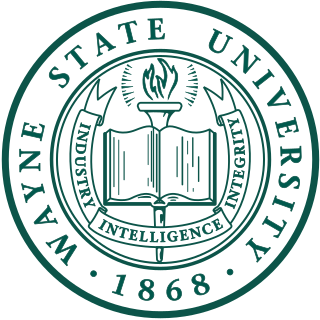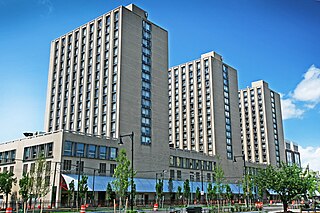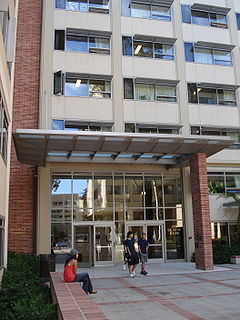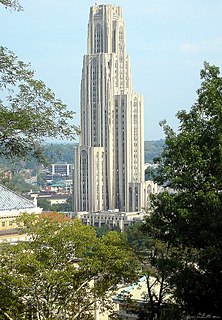Related Research Articles

Wayne State University (WSU) is a public research university in Detroit, Michigan. It is Michigan's third-largest university. Founded in 1868, Wayne State consists of 13 schools and colleges offering approximately 350 programs to more than 26,000 graduate and undergraduate students. Wayne State University, along with the University of Michigan and Michigan State University, compose the University Research Corridor of Michigan. Wayne State is classified among "R1: Doctoral Universities – Very high research activity".

The University of Denver (DU) is a private research university in Denver, Colorado. Founded in 1864, it is the oldest independent private university in the Rocky Mountain Region of the United States. It is classified among "R2: Doctoral Universities – High research activity". DU enrolls approximately 5,700 undergraduate students and 7,200 graduate students. The 125-acre (0.51 km2) main campus is a designated arboretum and is located primarily in the University Neighborhood, about five miles (8 km) south of downtown Denver.
University Park is the name given to the Pennsylvania State University's main campus located in both State College and College Township, Pennsylvania. The campus post office was designated "University Park, Pennsylvania" in 1953 by Penn State president Milton Eisenhower, after what was then Pennsylvania State College was upgraded to university status.

Penn State Behrend (PSB) is a commonwealth campus of Pennsylvania State University and it is located in Erie, Pennsylvania. PSB is a four-year university with over 5,000 students and over 250 faculty, in five academic programs: the Schools of Business, Engineering, Humanities, and Social Sciences, Science, and the Nursing Program. In addition to bachelor's degrees, PSB offers master's degrees in some programs as well as continuing education and non-degree programs.
Housing at the University of California, Berkeley includes student housing facilities run by the office of Residential and Student Service Programs (RSSP). Housing is also offered by off-campus entities such as fraternities and sororities and the Berkeley Student Cooperative (BSC).

The Boston University housing system is the 2nd-largest of any private university in the United States, with 76% of the undergraduate population living on campus. On-campus housing at BU is an unusually diverse melange, ranging from individual 19th-century brownstone town houses and apartment buildings acquired by the school to large-scale high-rises built in the 60s and 2000s.

The campus housing system at the University of Michigan in Ann Arbor, referred to as University Housing, provides living accommodations for approximately 10,000 undergraduate and graduate students. There is no requirement for first-year students to live in University Housing, yet approximately 97% of incoming students choose to do so. Every year, over 9,500 undergraduate students are housed in 18 residence halls on Central Campus, the Hill Neighborhood, and North Campus. Undergraduates, graduate students, and students with families can live in University Housing apartments in the Northwood Community on North Campus. Seven full-service dining halls as well as several retail shops provide students with daily dining options.

Housing at the Massachusetts Institute of Technology (MIT) consists of eleven undergraduate dormitories and nine graduate dorms. All undergraduate students are required to live in an MIT residence during their first year of study. Undergraduate dorms are usually divided into suites or floors, and usually have Graduate Resident Assistants (GRA), graduate students living among the undergraduates who help support student morale and social activities. Many MIT undergraduate dorms are known for their distinctive student cultures and traditions.

Student housing owned by the University of California, Los Angeles is governed by two separate departments: the Office of Residential Life, and Housing and Hospitality Services, and provides housing for both undergraduates and graduate students, on and off-campus.

Schenley Quadrangle is a cluster of University of Pittsburgh residence halls that is a Pittsburgh History and Landmarks Foundation Historic Landmark and are contributing properties to the Schenley Farms National Historic District in Pittsburgh, Pennsylvania, United States.

The upper campus residence halls at the University of Pittsburgh include Sutherland Hall, Panther Hall, K. Leroy Irvis Hall, the fraternity housing complex, and the Darragh Street Apartments. Among the newest residence facilities at the university, these buildings reside on the upper campus located near many of the school's athletic facilities. The upper campus resides approximately 200 feet (61 m) above the lower campus that lies along Forbes and Fifth Avenues, providing dramatic views along the hilltop and slopes. Planning for upper campus student housing originated in the late 1960s and early 1970s, but stalled due to community and political opposition until the early 1990s with opening of Sutherland Hall, the first major student residence constructed by Pitt in 29 years.

The residence hall system at the University of Central Florida in Orlando, Florida is administered by the Department of Housing and Residence Life. As of 2011, the system offers just under 6,500 beds on its main campus within five housing communities, 400 beds at the Rosen College of Hospitality Management, and 3,750 beds in university-affiliated housing.
Stony Brook University is the largest residential campus in the State University of New York system, with approximately 54.5% of its students living on campus. Housing at Stony Brook is issued and controlled by Stony Brook University Campus Residences, which provides 9,445 spaces in its 11 corridor style buildings, 19 suite style buildings, and 23 apartment style buildings to Undergraduate students, Graduate students, and students' families. The large majority of on-campus housing is provided to students on the university's west campus, but housing is available to those on east campus, and for Stony Brook Southampton students.

The main campus of the Georgia Institute of Technology occupies part of Midtown Atlanta, primarily bordered by 10th Street to the north, North Avenue to the south, and, with the exception of Tech Square, the Downtown Connector to the East, placing it well in sight of the Atlanta skyline. In 1996, the campus was the site of the athletes' village and a venue for a number of athletic events for the 1996 Summer Olympics. The construction of the Olympic Village, along with subsequent gentrification of the surrounding areas, significantly changed the campus.

The main campus is in North Philadelphia, about 1.5 miles (2.4 km) north of Center City. It occupies 118 acres (48 ha); an estimated 12,626 students live on or near it. Events for students and the public include concerts, performances, clubs, exhibits and lectures.

The campus of Stony Brook University is located in Stony Brook, New York and consists of 213 buildings over 1,454 acres of land. It is the largest public university in the state of New York in terms of land area. The campus was moved to Stony Brook in 1962 after originating in Oyster Bay, New York.
References
- ↑ "University of Denver Construction". Du.edu. Archived from the original on 2011-12-30. Retrieved 2011-12-02.
- ↑ Jackson, Margaret. "Developers rush to fill demand for off-campus apartments near DU". The Denver Post. Retrieved 2011-12-02.
- ↑ Archived March 13, 2010, at the Wayback Machine
- ↑ "Nagel Hall | Housing and Residential Education | University of Denver". Du.edu. Retrieved 2011-12-02.
- ↑ "University of Denver | Academic Projects | Indiana Limestone Fabrication & Carving - Bybee Stone Company". Bybeestone.com. Retrieved 2011-12-02.
- ↑ "Nagel Hall tries to make DU "greener" - News - The Clarion - University of Denver". Duclarion.com. Archived from the original on 2011-10-03. Retrieved 2011-12-02.
- ↑ "Dining Services, University of Denver". Du-dining.com. Retrieved 2011-12-02.
- ↑ Jackson, Margaret (2010-09-14). "Fund aims to rescue firms". The Denver Post. Retrieved 2011-12-02.
- ↑ "2008 Winter: University of Denver Magazine". Scribd.com. Retrieved 2011-12-02.